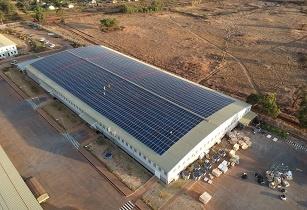With a considerable energy deficit and an expected increase in electricity demand, the Commercial and Industrial (C&I) sector to grow by more than 270% by 2030, Africa is on the path to becoming an attractive market for solar projects
Africa’s C&I solar sector encompasses various customer types, solar designs, and project sizes. Common customer types include businesses of different sizes – from large corporations to local small businesses – government offices, schools, and universities. C&I solar designs can take rooftop arrays on buildings, parking lots or ground mounts and project sizes varies from kilowatts to megawatts.
The solar photovoltaic (PV) industry primarily uses two distinct implementation models:
1.Captive Solar: In this model, energy is generated onsite from locally installed PV cells. Captive solutions may be implemented and installed on unutilised spaces like rooftops, car parks or open grounds.
Captive solar model can be segregated based on connectivity to the grid:
•On-grid captive: On-grid captive solar refers to solar PV systems installed in parallel with utility grid. Power may be drawn from the grid or fed to it from the captive unit at appropriate times, known as “Net Metering”.
•Off-grid captive: Off-grid installations are standalone solutions through which solar PV systems act as the primary energy source in conjunction with existing off-grid power sources. These existing sources act as secondary sources of energy as required.
2.Utility-Scale Solar: This model refers to large scale, ground-mounted solar projects with the state utility company acting as the off-taker under a Power Purchase Agreement (PPA).
Challenges:
The C&I sector in Africa improves economic activity and generates employment. But there are considerable gaps in other infrastructure sectors such as real estate, mines etc. in addition to other possible institutional/regulatory challenges like:
•No/limited regulatory support.
•Absence of official industrial standards and low technical awareness.
•Debt financing due to the project risk profile and credit profile of the developer/ offtaker.
•Economies of scale.
Opportunities:
Loss-making utilities are shifting to cost-reflective tariffs, pushing Africa’s grid-connected end-user tariffs upwards. In the long run, it is inevitable for utilities to increase their end-user tariffs to achieve profitability. This can have a significant impact on C&I market players because of increased costs, end-users will be incentivised to shift to cheaper and direct power sources like solar. Solar is the lowest cost solution in many areas of Africa and allows companies to have less external operational risk while enhancing their energy security.
Developers hope for fewer administrative delays and strong off-take agreements to pitch C&I customers directly and offer a low-cost off-grid solution and a hedge against future electricity tariff increases. Despite various challenges, multiple projects have achieved commercial and financial close, have completed the installation and are now operating successfully. The C&I solar sector is growing and is starting to play a key role in catering to the power demand in Africa.
Synergy Consulting has been instrumental in working on some of the key C&I projects across geographies, advising clients on multiple opportunities.




